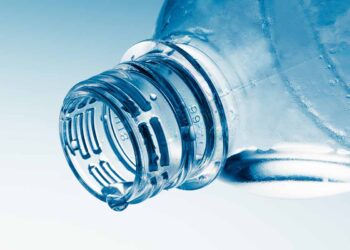Recycling for U.S. PET bottles in 2023 gained 4 percentage points on the year to reach 33%, the highest rate since 1996, according to a report from the National Association for PET Container Resources industry group.
The report noted that while PET resin imports were down on the year, imports of plastic scrap were up by about one-third.
In addition, the average amount of post-consumer RPET used in bottles and jars reached 16.2%, higher by 3 points from the previous year and the highest level to date, according to the annual NAPCOR report. The organization said the increase directly correlated to a higher percentage of RPET consumed in U.S. and Canadian end markets that went to bottle applications.
The U.S. collected 1.962 billion pounds of PET in 2023, higher by 2.7% from 2022 and the highest annual weight ever recorded. However, only 5.952 billion pounds of PET bottles were available, lower by 9.8% on the year.
Reclaimers reported purchasing higher volumes on the year, indicating a continuing rebound from pandemic-related effects, the report said. Curbside collection of bottles dropped during the COVID-19 pandemic, largely due to reduced consumer travel and attendance at activities where bottled beverages are purchased.
Volatility in pricing for both virgin and recycled PET also eased in 2023. “During the peak of bale pricing in 2022, there was a significant premium for rPET over virgin PET (VPET), but this gap had collapsed by the end of the year following steep pricing declines in both chains,” the report said. However, in 2024 RPET prices increased while virgin PET prices continued to soften, leading RPET to regain a “significant” pricing premium.
Imports come into focus
Although mechanical recycling capacity expansions in the U.S. and Canada are planned, very little growth in operational capacity has occurred since the end of 2022, which has led to increased imports of RPET to meet growing demand, according to the report. Of the 1.792 billion pounds of RPET consumed in U.S. and Canadian end markets, 345 million were imported from outside the two countries.
In the U.S., imports account for 44% of virgin PET production capacity, according to the report, as domestic supply is structurally short.
Even so, imports of all PET resin fell by 12.1% on the year, with resin featuring specifications best suited for bottle production falling by 14.5%. This drop, combined with a 36% increase in PET scrap imports, led NAPCOR to speculate that some RPET flake and pellet had been imported under the tariff code for plastic scrap. During that time, however, deep-sea freight rates into the U.S. were at low levels due to depressed global demand, which helped make imported material more competitively priced.
Fiber applications continue to lose ground
In its biennial survey on polyester fiber production, NAPCOR found that U.S. producers decreased post-consumer RPET use by 27.6% between 2021 and 2023, to 496 million pounds. The filament segment, which includes carpet and textiles, saw the most dramatic decrease. NAPCOR attributed the drop of 33.8% to high mortgage interest rates that suppressed the housing and construction industry in 2023 – a key sector for carpeting.
Prior to 2018, polyester fiber was the primary end market for RPET in North America, but in 2020 bottle production first surpassed fiber, and the gap has widened since. “This shift reflects corporate commitments to increase recycled content in packaging and increased legislative pressure for more rPET content in bottles,” the report’s authors wrote.
The amount of RPET used in bottling increased by 11% to 966 million pounds, and the share used in bottling rose to a new high of 59%, higher by 5 points on the year.
Thermoforms trend away from virgin resin
The year marked the fourth survey of PET thermoform converters in the U.S. and Canada. Virgin material comprised 74% of total sheet PET and resin purchases, compared to 83% in 2022. This represents a shift toward recycled feedstock, the report said, primarily RPET sourced from post-consumer bottle bales, which composed 17% of PET entering the market during 2023.
The press release noted that PET is recycled at higher rates than other plastics, citing data from The Recycling Partnership’s State of Recycling report. TRP pegged recycling for PET bottles from residential sources at 28%, versus 26% and 22% for HDPE natural and color bottles, respectively.
Compared to other container materials, PET lags aluminum cans but remains above glass, according to a recent report from the Aluminum Association and Can Manufacturers Institute. That report cited a 43% consumer recycling rate for aluminum beverage cans in 2023.
NAPCOR bases its yearly report on survey data, market interviews, import data and its own independent analysis. In representing the North American PET packaging industry, the organization promotes PET packaging, overcoming recycling hurdles and communicating PET as a sustainable material for containers.






















